Sailfin Molly
-
Scientific NamePoecilia latipinna
-
NativeNon-Native
-
Identification
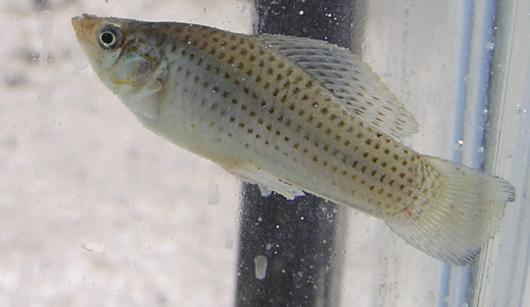 Sailfin molly, male, left side. Location: Irrigation drain (Oasis-Grant Drain) at the north end of the Salton Sea. Date: 2010. Photo by Sharon Keeney, California Department of Fish and Game.
Sailfin molly, male, left side. Location: Irrigation drain (Oasis-Grant Drain) at the north end of the Salton Sea. Date: 2010. Photo by Sharon Keeney, California Department of Fish and Game.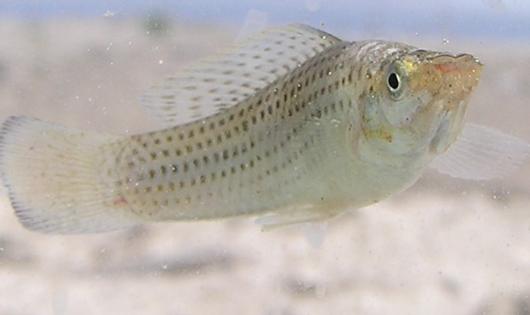 Sailfin molly, male, frontal view. Location: Irrigation drain (Oasis-Grant Drain) at the north end of the Salton Sea. Date: 2010. Photo by Sharon Keeney, California Department of Fish and Game.
Sailfin molly, male, frontal view. Location: Irrigation drain (Oasis-Grant Drain) at the north end of the Salton Sea. Date: 2010. Photo by Sharon Keeney, California Department of Fish and Game.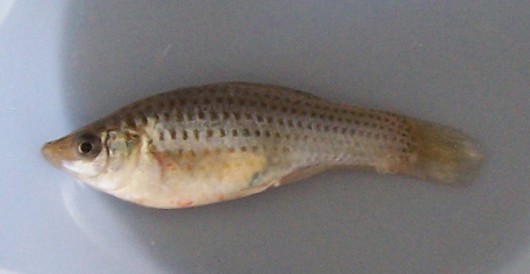 Sailfin molly, female, left side. Weight 1.9 g. Photographed on 05/30/2009, by Barbara A. Martin, USGS.
Sailfin molly, female, left side. Weight 1.9 g. Photographed on 05/30/2009, by Barbara A. Martin, USGS.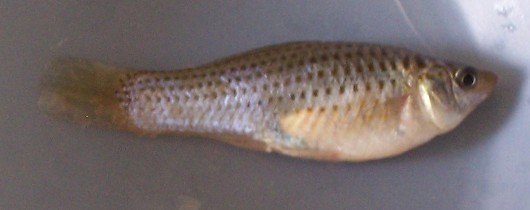 Sailfin molly, female, right side. Weight 1.9 g. Photographed on 05/30/2009, by Barbara A. Martin, USGS.
Sailfin molly, female, right side. Weight 1.9 g. Photographed on 05/30/2009, by Barbara A. Martin, USGS.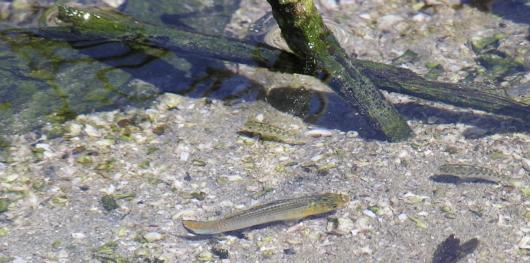 Sailfin molly, male (bottom, center), and desert pupfish. Location: Irrigation drain (Arthur 0.5 Drain) near the Salton Sea. Date: 2006. Photo by Sharon Keeney, California Department of Fish and Game.
Sailfin molly, male (bottom, center), and desert pupfish. Location: Irrigation drain (Arthur 0.5 Drain) near the Salton Sea. Date: 2006. Photo by Sharon Keeney, California Department of Fish and Game.- Chunky bodied with an oblique mouth
- Males have long sail-like dorsal fins (13-16 rays)
- Males also have an anal fin with 9-10 rays, the first few rays modified into a gonopodia
- Females have shorter dorsal fins and unmodified anal fin rays
- Both have pectoral fins with 13 rays and pelvic fins with 6 rays
- 23-28 scales on the lateral line
- Brown on the back gradually changing to iridescent blue or pink on the sides and white on the belly
- 5-6 horizontal rows of stripes
- Pale blue dorsal fin with rows of black spots and a yellow border
- Females more pale in color than males
- A California color variant may have the whole body iridescent black with an orange border on the dorsal fin and heavy speckling on the side
-
Life History
Sailfin mollies are commonly found in estuaries, stagnant drains, shoreline pools and other harsh, brackish habitats throughout the intensely irrigated Imperial valley. With their ability to survive in salinities as high as 87 ppt they can also be found in the Salton Sea itself. While they may be able to stand intense salinities their habitat selection is more restricted by temperature as anything lower than 24°C stops growth and reproduction. Detritus is their main food source followed by algae, and they will only feed on invertebrates when they are incredibly abundant.
Females mature when they reach 25-40 mm in length, and males mature at 20-30 mm. This usually happens within 110-150 days of birth but environmental conditions including temperature and salinity can influence their growth and development. Once they mature, courtship and copulation happens rapidly. Females can store various batches of eggs at one time allowing for a single copulation to fertilize all of them. Embryos feed from both yolk sac and from the mother in utero, leading to bigger and more independent young. The number of offspring each female can produce varies with her size, the local water temperature, and salinity. Sailfin mollies from ditches usually hold between 20 and 60 eggs but numbers as high as 141 have been found.
Sailfin mollies can grow as much as 15 cm in a year but few exceed 8 cm. For males, size is partially determined by the density of predators in the area. Dangerous areas will see males with smaller bodies and less colorful markings making them less conspicuous to predators. Larger and more bold looking fish are found in areas where avoiding predators is less of a concern than attracting females.
-
Links to Other ResearchN / A
-
WatershedN / A
Please note, watersheds are at the USGS 8-digit Hydrologic Unit Code (HUC) scale, so they often include a lot of sub-watersheds. If a species occurs in any sub-watershed within the HUC, the species appears within the HUC. Link to an EPA page that shows HUCs.




